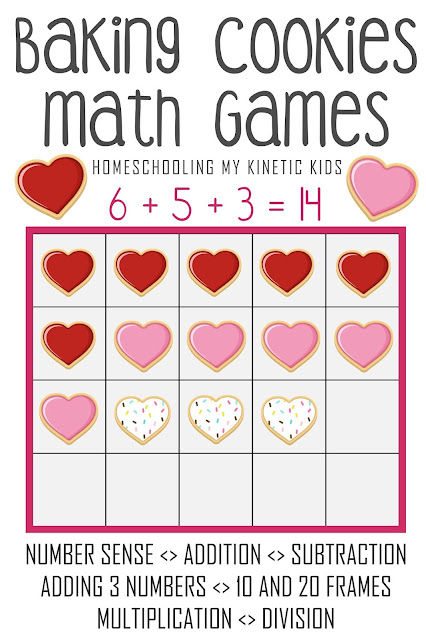Cookie Baking Math Games
It's officially the end of holiday season (well, if you don't count the 12 days until Epiphany), and I feel like I'm allowed to post a non-Christmas printable. The crazy thing is that I fought really hard for this not to be a "Christmas Cookie" game, because I feel like there are SO MANY Christmas printables on the web and not enough activities for after Christmas. It was very hard to not use fun gingerbread graphics, so I'm sure I'll do a Christmas one next year. I'll probably do several varieties over the next year.
This printable was inspired by Dragonfly, who has been working through a Horizons 1st Grade Math book. In the curriculum, she has run up against addition with three numbers and it's messing her up. Her confidence had taken a hit, and she's frequently getting the wrong answer, which is unusual. I needed to make a math manipulative to help her see that addition was the same concept no matter how many numbers you were adding together.
I really wanted this printable to appeal to my 7 year old girl. After spending way too many hours browsing for graphics and brainstorming, I finally settled on these heart-shaped sugar cookies. Originally, I was thinking about using a cookie sheet for grouping the cookies, which is why I called it "baking." In the end, I decided that the 10 and 20 frames had more universal use and were more standard for math lessons.
Since the original purpose of the printable was to help Dragonfly with addition, I'll start my explanation of the printable there. During my demonstration, I had her working out of her math workbook, so the numbers for the equation were already provided. I simply had her represent each number with a different frosting color. She was amazed how easy her workbook was after using the cookies. Mission accomplished.
For kids who are just learning their numbers, the printable contains a number line for control of error. The number cards can be put in a row to show the relationships between them. There are 30 cookies included in the PDF, but more could be printed to get the 55 you need to do numbers 1-10,
The numbers can also be represented on the 10 and 20 frames to help build number sense. My kids like to play a game where I tell them the number I want to see and they show me on the frame. Alternatively, you could have them roll a dice, like this 10-sided one, to create numbers. Another idea would be to have the child draw a number card out of a pile or cup or to use a random number generator app on a device.
Of course, the 10 and 20 frames can also be used for subtraction practice. Simply put the larger number on the board and then take away the number you need to do for the equation. The cookies that are left is your answer.
Although it's less common, 10 and 20 frames can help kids learn beginning multiplication and division. Types of cookies can be grouped on the board in ways that show their relationship to each other and the equation. In the example above, I used three groups of four cookies to make the number 12. Similarly, in arranging the cookies on the grid, concepts related to division can be explored.
The printable includes thirty printable cookies in three designs (I put mine on cardstock for weight), number cards 1-20 with repeated numbers for equations, math symbols, a number line, and 10 and 20 box frames. Most of younger elementary math can be explored with this packet including number sense, addition, subtractions, multiplication, division, fractions, and more. The set is very open ended and could be used for additional math activities and games according to the child's interests or teacher's learning goals.
Oh, have I mentioned that I also designed the whole things to fit in an Altoid tin? It's becoming my favorite way to organize math games. Scroll to the end of the post for lots of ideas, and look for more Altoid tin posts in the future!
> > > Click Here to Download the Printable < < <
Pin It!












Comments
Post a Comment
Thank you for commenting!